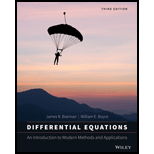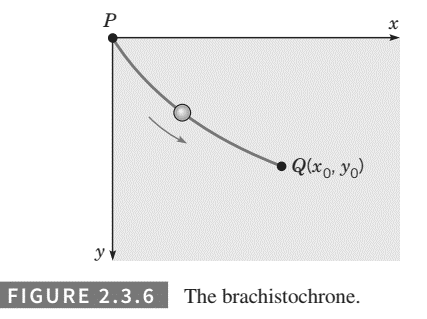
Brachistochrone Problem. One of the famous problems in the history of mathematics is the brachistochronproblem: to find the curve along which a particle will slidewithout friction in the minimum time from one given point
In solving this problem, it is convenient to take the originas the upper point
 possible to show that the curve of minimum time is given by a function
possible to show that the curve of minimum time is given by a function
Where
Solve Eq. (i) for
Introduce the new variable
Show that equation found in part (a) then takes the form
Letting
…. (iv)
Equations (iv) are parametric equations of the solution of Eq. (i) that passes through
If we make a proper choice of the constant
Want to see the full answer?
Check out a sample textbook solution
Chapter 2 Solutions
Differential Equations: An Introduction to Modern Methods and Applications
Additional Math Textbook Solutions
Calculus for Business, Economics, Life Sciences, and Social Sciences (14th Edition)
Intro Stats, Books a la Carte Edition (5th Edition)
Elementary Statistics
Calculus: Early Transcendentals (2nd Edition)
Pre-Algebra Student Edition
- question 3 part a and barrow_forwarddo question 2arrow_forward21. ANALYSIS OF LAST DIGITS Heights of statistics students were obtained by the author as part of an experiment conducted for class. The last digits of those heights are listed below. Construct a frequency distribution with 10 classes. Based on the distribution, do the heights appear to be reported or actually measured? Does there appear to be a gap in the frequencies and, if so, how might that gap be explained? What do you know about the accuracy of the results? 3 4 555 0 0 0 0 0 0 0 0 0 1 1 23 3 5 5 5 5 5 5 5 5 5 5 5 5 6 6 8 8 8 9arrow_forward
- A side view of a recycling bin lid is diagramed below where two panels come together at a right angle. 45 in 24 in Width? — Given this information, how wide is the recycling bin in inches?arrow_forwardf'(x)arrow_forwardIf you are using chatgpt leave it I will downvote .arrow_forwardTemperature measurements are based on the transfer of heat between the sensor of a measuring device (such as an ordinary thermometer or the gasket of a thermocouple) and the medium whose temperature is to be measured. Once the sensor or thermometer is brought into contact with the medium, the sensor quickly receives (or loses, if warmer) heat and reaches thermal equilibrium with the medium. At that point the medium and the sensor are at the same temperature. The time required for thermal equilibrium to be established can vary from a fraction of a second to several minutes. Due to its small size and high conductivity it can be assumed that the sensor is at a uniform temperature at all times, and Newton's cooling law is applicable. Thermocouples are commonly used to measure the temperature of gas streams. The characteristics of the thermocouple junction and the gas stream are such that λ = hA/mc 0.02s-1. Initially, the thermocouple junction is at a temperature Ti and the gas stream at…arrow_forwardA body of mass m at the top of a 100 m high tower is thrown vertically upward with an initial velocity of 10 m/s. Assume that the air resistance FD acting on the body is proportional to the velocity V, so that FD=kV. Taking g = 9.75 m/s2 and k/m = 5 s, determine: a) what height the body will reach at the top of the tower, b) how long it will take the body to touch the ground, and c) the velocity of the body when it touches the ground.arrow_forwardA chemical reaction involving the interaction of two substances A and B to form a new compound X is called a second order reaction. In such cases it is observed that the rate of reaction (or the rate at which the new compound is formed) is proportional to the product of the remaining amounts of the two original substances. If a molecule of A and a molecule of B combine to form a molecule of X (i.e., the reaction equation is A + B ⮕ X), then the differential equation describing this specific reaction can be expressed as: dx/dt = k(a-x)(b-x) where k is a positive constant, a and b are the initial concentrations of the reactants A and B, respectively, and x(t) is the concentration of the new compound at any time t. Assuming that no amount of compound X is present at the start, obtain a relationship for x(t). What happens when t ⮕∞?arrow_forwardConsider a body of mass m dropped from rest at t = 0. The body falls under the influence of gravity, and the air resistance FD opposing the motion is assumed to be proportional to the square of the velocity, so that FD = kV2. Call x the vertical distance and take the positive direction of the x-axis downward, with origin at the initial position of the body. Obtain relationships for the velocity and position of the body as a function of time t.arrow_forwardAssuming that the rate of change of the price P of a certain commodity is proportional to the difference between demand D and supply S at any time t, the differential equations describing the price fluctuations with respect to time can be expressed as: dP/dt = k(D - s) where k is the proportionality constant whose value depends on the specific commodity. Solve the above differential equation by expressing supply and demand as simply linear functions of price in the form S = aP - b and D = e - fParrow_forwardFind the area of the surface obtained by rotating the circle x² + y² = r² about the line y = r.arrow_forwardarrow_back_iosSEE MORE QUESTIONSarrow_forward_ios
- Algebra & Trigonometry with Analytic GeometryAlgebraISBN:9781133382119Author:SwokowskiPublisher:Cengage
 Mathematics For Machine TechnologyAdvanced MathISBN:9781337798310Author:Peterson, John.Publisher:Cengage Learning,
Mathematics For Machine TechnologyAdvanced MathISBN:9781337798310Author:Peterson, John.Publisher:Cengage Learning,

